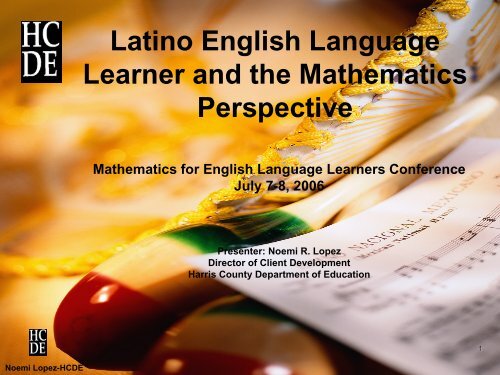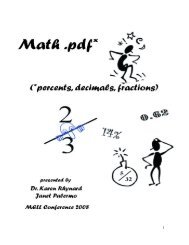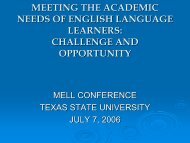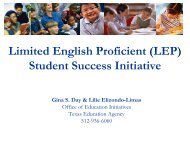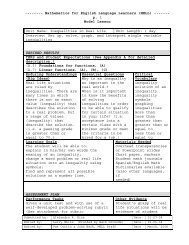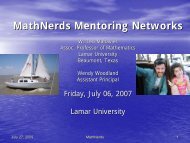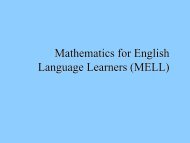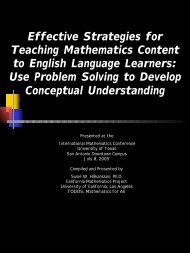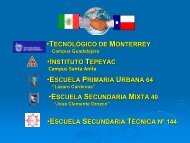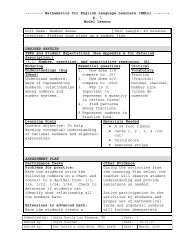Latino English Language Learner and the Mathematics Perspective
Latino English Language Learner and the Mathematics Perspective
Latino English Language Learner and the Mathematics Perspective
You also want an ePaper? Increase the reach of your titles
YUMPU automatically turns print PDFs into web optimized ePapers that Google loves.
<strong>Latino</strong> <strong>English</strong> <strong>Language</strong><br />
<strong>Learner</strong> <strong>and</strong> <strong>the</strong> Ma<strong>the</strong>matics<br />
<strong>Perspective</strong><br />
Ma<strong>the</strong>matics for <strong>English</strong> <strong>Language</strong> <strong>Learner</strong>s Conference<br />
July 7-8, 2006<br />
Presenter: Noemi R. Lopez<br />
Director of Client Development<br />
Harris County Department of Education<br />
1<br />
Noemi Lopez-HCDE
<strong>Perspective</strong>- Two views<br />
Ma<strong>the</strong>matics<br />
<strong>English</strong><br />
<strong>Language</strong> <strong>Learner</strong><br />
2<br />
Noemi Lopez-HCDE
It takes a village to raise a<br />
child." The village of <strong>the</strong> present,<br />
however, is not <strong>the</strong> suburb or<br />
small town of memory or<br />
nostalgia but <strong>the</strong> global village,<br />
<strong>the</strong> "network of values <strong>and</strong><br />
relationships that support <strong>and</strong><br />
affect our lives."<br />
Hillary Rodham Clinton<br />
3<br />
Noemi Lopez-HCDE
Hispanic Americans<br />
☯Who Who or what identifies an individual as<br />
Hispanic/<strong>Latino</strong>?<br />
☯ Create an underst<strong>and</strong>ing of <strong>the</strong> Hispanic culture<br />
☯How How can we help <strong>and</strong> underst<strong>and</strong> <strong>the</strong><br />
Hispanic child in school?<br />
☯Current educational findings<br />
☯ How do we marry <strong>the</strong> ELL to <strong>the</strong> world of<br />
ma<strong>the</strong>matics?<br />
4<br />
Noemi Lopez-HCDE
<strong>Latino</strong><br />
American<br />
South<br />
Noemi Lopez-HCDE<br />
5<br />
Hispanic<br />
Spaniard<br />
Mexican<br />
Puerto Rican
Hispanic Americans<br />
☯ Is Hispanic <strong>the</strong> same as <strong>Latino</strong>, Mexican,<br />
Columbiano, Puerto Rican, Chicano?<br />
☯ Is it correct to ask,”Are you Spanish?<br />
☯ If you were given crayons, what color<br />
would you pick to portray an Hispanic<br />
child?<br />
☯ Is Hispanic a “race”?<br />
Noemi Lopez-HCDE<br />
☯ Are all Hispanic Americans immigrants?<br />
6
The Name<br />
Hispanic <strong>and</strong> <strong>Latino</strong> are both labels used to describe<br />
people who come from a variety of countries <strong>and</strong><br />
cultural backgrounds. In <strong>the</strong>ir countries of origin, <strong>the</strong>se<br />
people would not use ei<strong>the</strong>r label to describe<br />
<strong>the</strong>mselves. Instead, <strong>the</strong>y would use a label that<br />
describes <strong>the</strong>ir country of origin or ethnic group<br />
identification.<br />
They are:<br />
Cubans, Chicanos, Mexicans,<br />
Puerto Ricans, Argentineans, Colombians,<br />
Dominicans, Brazilians, Guatemalans,<br />
Costa Ricans, Nicaraguans, Salvadorians,<br />
<strong>and</strong> all <strong>the</strong> o<strong>the</strong>r nationalities that comprise South<br />
America, Central America, <strong>and</strong> <strong>the</strong> Caribbean.<br />
Noemi Lopez-HCDE<br />
It is when <strong>the</strong>y come to <strong>the</strong> United States that<br />
<strong>the</strong> label of Hispanic or <strong>Latino</strong> is given to<br />
<strong>the</strong>m.<br />
7
Hispanic<br />
HISPANIC derives from <strong>the</strong> mostly white<br />
Iberian Peninsula that encompasses <strong>the</strong><br />
European countries of Spain <strong>and</strong> Portugal.<br />
Persons who descend directly from Spain or<br />
from one of <strong>the</strong> many cultures in <strong>the</strong> world<br />
that owe <strong>the</strong>ir origins to Spain<br />
Spaniards<br />
Latin Americans<br />
Noemi Lopez-HCDE<br />
For U.S. government statistics: 1970’s<br />
became a reference to all Spanish-speaking<br />
ethnic subgroups- All Americans who trace<br />
<strong>the</strong>ir ancestry to Mexico, Puerto Rico, Cuba,<br />
Spain, <strong>the</strong> Spanish speaking countries of<br />
Central <strong>and</strong> South America, <strong>the</strong> Dominican 8<br />
Republic
LATINOS<br />
LATINO derives from <strong>the</strong> brown indigenous<br />
people of <strong>the</strong> Americas- Mexico, Central America,<br />
<strong>and</strong> South America<br />
☯<br />
Countries include:<br />
• Mexico from North America<br />
• Nations in Central America<br />
• Nations in South America<br />
• Brazilian is a <strong>Latino</strong>, but not a Hispanic<br />
• Cuba in <strong>the</strong> West Indies<br />
• Some isl<strong>and</strong>s of <strong>the</strong> Caribbean Sea<br />
9<br />
Noemi Lopez-HCDE
OTHER NAMES<br />
CHICANO- refers only to a Mexican American,<br />
an American of Mexican descent<br />
SPANISH AMERICAN- an American whose<br />
family comes from Spain<br />
MEXICAN<br />
MEXICAN- a Mexican Citizen ( in Mexico or US)<br />
as an identity, a person from Mexico<br />
Mexican American- A US citizen of Mexican<br />
descent<br />
10<br />
Noemi Lopez-HCDE
Hispanic/<strong>Latino</strong>s<br />
Brief History<br />
11<br />
Noemi Lopez-HCDE
REASONS FOR IMMIGRATION<br />
There are two types of motivation for immigration<br />
Push (need to leave in order to<br />
survive)<br />
• Political Freedom<br />
• Religious Tolerance<br />
• Political Refugees;fear for <strong>the</strong>ir lives<br />
• Persistent poverty, hunger<br />
• Insufficient l<strong>and</strong>s<br />
Pull (attracted to new way of life)<br />
• Economic Opportunity - People want a better life -<br />
better job - more money<br />
• Freedom to pursue personal goals<br />
• Family Reunification<br />
12<br />
Noemi Lopez-HCDE
Hispanics/<strong>Latino</strong>s<br />
•descendents from countries<br />
settled by Spain<br />
<strong>Latino</strong>s<br />
* descendents from Spain<br />
Mexican<br />
Americans<br />
Central<br />
Americans<br />
Puerto<br />
Ricans<br />
South<br />
Americans<br />
Cubans<br />
13<br />
Noemi Lopez-HCDE
Mexican American<br />
• Immigrants from Mexico<br />
• California, Texas, New Mexico, <strong>and</strong> Arizona were<br />
annexed into <strong>the</strong> Union by conquest or purchase<br />
• After <strong>the</strong> Mexican American War, Mexico lost 45% of its<br />
national territory <strong>and</strong> well over 100,000 of its people to<br />
<strong>the</strong> United States.<br />
• A rise in <strong>the</strong> number of Mexican migrants to <strong>the</strong> United<br />
States was precipitated by <strong>the</strong> Mexican Revolution of<br />
1910. Thous<strong>and</strong>s fled <strong>the</strong> turmoil of <strong>the</strong> revolutionary<br />
process to find work in industry, agriculture <strong>and</strong><br />
transportation<br />
Noemi Lopez-HCDE<br />
• A new wave of immigration was fostered by <strong>the</strong> Second<br />
World War. A shortage of farm workers developed in <strong>the</strong><br />
U.S. as people left <strong>the</strong> l<strong>and</strong> to enter <strong>the</strong> armed forces or<br />
work in <strong>the</strong> war effort. The U.S. <strong>and</strong> Mexico negotiated<br />
<strong>the</strong> "Bracero" agreement which issued Mexicans<br />
temporary work permits to work in <strong>the</strong> fields.<br />
14
Noemi Lopez-HCDE<br />
15
Puerto Ricans<br />
☯<br />
Puerto Rico-Spanish colony, plantations, mixed<br />
European <strong>and</strong> African<br />
☯<br />
Spanish-American War 1898, becomes US colony<br />
☯<br />
March 2, 1919, President Woodrow Wilson signed<br />
<strong>the</strong> Jones Act during World War I in part for <strong>the</strong> need<br />
of more soldiers- Puerto Ricans are citizens of US<br />
(<strong>the</strong>refore non-immigrants)<br />
☯<br />
2 nd largest group of <strong>Latino</strong>s<br />
☯ 1948- made a Commonwealth, Associated Free<br />
State, yet not a state<br />
16<br />
Noemi Lopez-HCDE
Cubans<br />
☯ Cuba gained its independence in 1902 but remained<br />
tied to U.S. economic interests until <strong>the</strong> revolution in<br />
1959<br />
☯ First-wave Cubans left between 1959 <strong>and</strong> 1965 <strong>and</strong><br />
were predominantly white, upper <strong>and</strong> middle class<br />
with educational, business, <strong>and</strong> financial resources.<br />
☯ The second wave (from 1965 to 1973) was composed<br />
of middle class, lower middle class <strong>and</strong> working class<br />
persons.<br />
☯ The third wave began in <strong>the</strong> Summer of 1980 with <strong>the</strong><br />
Mariel boat lift<br />
☯ Descendents: Spaniards, Chinese, African mulattos<br />
17<br />
Noemi Lopez-HCDE
Central Americans<br />
☯ The 1980s political turmoil in Nicaragua, El Salvador,<br />
<strong>and</strong>, to a lesser degree, Guatemala precipitated new<br />
waves of migration into <strong>the</strong> States. The Nicaraguans<br />
were welcomed as political refugees fleeing political<br />
repression, while Salvadorans <strong>and</strong> Guatemalans were<br />
considered to be migrating for economic reasons <strong>and</strong><br />
often faced deportation by <strong>the</strong> immigration authorities.<br />
☯ El Salvador- largest group; majority came during civil war.<br />
☯ Guatemala- mostly in 1990s due to civil war<br />
☯ Nicaragua-fled S<strong>and</strong>inistas (Communist regime); largely<br />
white <strong>and</strong> well educated.<br />
☯ Honduras-<br />
☯ Panama<br />
☯ Costa Rica<br />
Noemi Lopez-HCDE<br />
☯ Guatemalans, Salvadorans <strong>and</strong> Hondurans- Many<br />
violently forced off <strong>the</strong> l<strong>and</strong>, are culturally <strong>and</strong> ethnically<br />
distinct. Typically very poor.<br />
☯ Note: The state of Texas is bigger than <strong>the</strong> entire region<br />
of Central America.<br />
18
South Americans<br />
☯ There are twelve independent nations<br />
☯ 9 are Hispanic: Argentina, Bolivia, Chile,<br />
Colombia, Ecuador, Paraguay, Peru, Uruguay<br />
<strong>and</strong> Venezuela<br />
3 non-Hispanic: Guyana, Suriname <strong>and</strong> Brazil<br />
☯ Tend not to think of <strong>the</strong>mselves as SA, but<br />
identify <strong>the</strong>mselves with <strong>the</strong>ir home country.<br />
☯ Some Argentineans <strong>and</strong> Chileans fled<br />
repressive governments during <strong>the</strong> late '60s<br />
<strong>and</strong> '70s.<br />
☯ 1.5 million living in U.S. from 1820-1995<br />
1995<br />
19<br />
Noemi Lopez-HCDE
Hispanic Americans<br />
☯ Is it correct to ask,”Are you Spanish?<br />
☯ If you were given crayons, what color would<br />
you pick to portray an Hispanic child?<br />
☯ Is Hispanic a “race”?<br />
20<br />
Noemi Lopez-HCDE
Hispanic ≠ race.<br />
People who identify <strong>the</strong>ir origin as<br />
Spanish, Hispanic, or <strong>Latino</strong> may be<br />
of any race- could choose one or<br />
more race categories<br />
21<br />
Noemi Lopez-HCDE
Hispanic ≠ race.<br />
• Census defined only 6 race groups<br />
• White<br />
• Black or African American<br />
• American Indian<br />
• Alaska Native<br />
• Asian<br />
• Native Hawaiian <strong>and</strong> O<strong>the</strong>r Pacific<br />
Isl<strong>and</strong>ers<br />
• Census 2000- Define Hispanic origin:<br />
Mexican, Mexican Am. Chicano, Puerto<br />
Rican, Cuban, o<strong>the</strong>r<br />
Spanish/Hispanic/<strong>Latino</strong>; Spanish,<br />
Honduran , Venezuelan etc.<br />
22<br />
Noemi Lopez-HCDE
Statistics<br />
23<br />
Noemi Lopez-HCDE
Population Size <strong>and</strong> Composition<br />
In March 2000, 32.8 million Hispanics lived in<br />
<strong>the</strong> United States.<br />
• 12% of <strong>the</strong> U.S. population is Hispanic.<br />
• People of Mexican origin comprise<br />
approximately 66% of <strong>the</strong> U.S. Hispanic<br />
population.<br />
Source: Current Population Survey, March 2000, PGP-4
Percent Distribution of Hispanics<br />
by Type: 2000<br />
Central <strong>and</strong><br />
South<br />
American<br />
15%<br />
O<strong>the</strong>r<br />
Hispanic<br />
6%<br />
Cuban<br />
4%<br />
Puerto Rican<br />
9%<br />
Mexican<br />
66%<br />
Source: Current Population Survey, March 2000, PGP-4
Noemi Lopez-HCDE<br />
26
Age Distribution by Sex <strong>and</strong><br />
Hispanic Origin: 2000<br />
(In percent)<br />
Hispanic<br />
age<br />
Non-Hispanic<br />
White<br />
85+<br />
Male Female Male<br />
Female<br />
80-84<br />
75-79<br />
70-74<br />
65-69<br />
60-64<br />
55-59<br />
50-54<br />
45-49<br />
40-44<br />
35-39<br />
30-34<br />
25-29<br />
20-24<br />
15-19<br />
10-14<br />
5-9<br />
0-4<br />
15 10 5 0 5 10 15 15 10 5 0 5 10 15<br />
Source: Current Population Survey, March 2000, PGP-4<br />
One-third of Hispanics are under age 18.
Poverty<br />
Hispanics are more likely to be living in poverty<br />
than non-Hispanic Whites.<br />
• Over one quarter of Hispanic children under age<br />
18 live in poverty.<br />
Source: Current Population Survey, March 2000, PGP-4
Regional Population Distribution<br />
by Hispanic Origin: 2000<br />
Hispanic<br />
14%<br />
Non-Hispanic<br />
White<br />
20% 20%<br />
45%<br />
8%<br />
Nor<strong>the</strong>ast<br />
Midwest<br />
South<br />
33%<br />
West<br />
33%<br />
27%<br />
Source: Current Population Survey, March 2000, PGP-4
Hispanic Americans<br />
How can we help <strong>and</strong> underst<strong>and</strong> <strong>the</strong><br />
Hispanic child in school?<br />
☯ Know <strong>the</strong> child<br />
☯ Create an underst<strong>and</strong>ing of <strong>the</strong> Hispanic culture<br />
☯ Current educational findings<br />
30<br />
Noemi Lopez-HCDE
CULTURE<br />
•Being <strong>Latino</strong> is not an issue of race, it’s an issue of<br />
culture<br />
•La cultura es un tesoro que sigue a su dueño a todas<br />
partes.<br />
(Culture is a treasure which follows its owner everywhere)<br />
Chinese proverb<br />
•The teacher in an inner-city school set out to<br />
underst<strong>and</strong> <strong>the</strong> obstacles to learning that her students<br />
experienced, only to find that she was one of <strong>the</strong>m….<br />
•“ The social nature of teaching <strong>and</strong> learning dem<strong>and</strong>s<br />
that teachers have an underst<strong>and</strong>ing of <strong>the</strong>ir students to<br />
build culturally appropriate climates.”<br />
Sussman, , Grace. “The Violence You Don’t t See.” Summer 2006 ASCD<br />
Online Educational Leadership.<br />
31<br />
Noemi Lopez-HCDE
Culture<br />
• Culture can be defined as a way of life,<br />
especially as it relates to <strong>the</strong> socially<br />
transmitted habits, customs, traditions <strong>and</strong><br />
beliefs that characterize a particular group of<br />
people at a particular time. It includes<br />
behaviors, actions, practices, attitudes, norms<br />
<strong>and</strong> values, communications (language),<br />
patterns, traits etiquette, spirituality,etc.<br />
• Culture is <strong>the</strong> lens through which we look at<br />
<strong>the</strong> world . It is <strong>the</strong> context within which we<br />
operate <strong>and</strong> make sense of <strong>the</strong> world <strong>and</strong> its<br />
influences on how we process learning, solve<br />
problems <strong>and</strong> teach.<br />
32<br />
Edwards, Ellis, Ko, Saifer <strong>and</strong> Stuczynski (2004) Classroom to community <strong>and</strong> back: Using Culturally responsive st<strong>and</strong>ardsbased<br />
(CRSB) teaching to streng<strong>the</strong>n family <strong>and</strong> community partnerships <strong>and</strong> increased student achievement, Noemi Lopez-HCDE<br />
NWREL,
Hispanic Culture<br />
Noemi Lopez-HCDE<br />
☯ <strong>Language</strong>-Spanish; First <strong>Language</strong>?<br />
☯ Machismo<br />
☯ Hard workers<br />
☯ Formality; Respect<br />
☯ Family Solidarity<br />
• Value of Families<br />
• Intergenerational Family Relations<br />
• Pattern of Influence <strong>and</strong> Control<br />
☯ Food<br />
• Similarities in ingredients <strong>and</strong> spices<br />
☯ Religion<br />
☯ Value Education<br />
☯ Generational<br />
33
Hispanic Culture<br />
<strong>Language</strong>-Spanish<br />
☯ May or may not be first language.<br />
☯ There are no dialects, <strong>the</strong>re is just one Spanish<br />
language. However, Spanish is not always <strong>the</strong> "same"<br />
Spanish. It is possible for Hispanics to underst<strong>and</strong> each<br />
o<strong>the</strong>r because <strong>the</strong>y all speak <strong>the</strong> same language. Yet, <strong>the</strong>re<br />
are some significant differences depending on <strong>the</strong> country<br />
of origin. Think of it as <strong>the</strong> difference between British<br />
<strong>English</strong>, American <strong>English</strong>, <strong>and</strong> Australian <strong>English</strong>. There is<br />
no doubt that you can communicate with each o<strong>the</strong>r, but<br />
sometimes <strong>the</strong> meaning is lost due to regional differences.<br />
A person trained in Castilian Spanish may have a perfect<br />
translation that becomes offensive to Mexican-Americans.<br />
Spanish-language maintenance<br />
Although <strong>Latino</strong>s learn <strong>English</strong> with each successive<br />
generation in <strong>the</strong> U.S., many children are bilingual <strong>and</strong><br />
continue to learn <strong>and</strong> use Spanish <strong>and</strong> <strong>English</strong>. This<br />
reflects positive attitudes <strong>Latino</strong>s have towards <strong>the</strong>ir<br />
language <strong>and</strong> <strong>the</strong> desire to preserve it as part of <strong>the</strong>ir<br />
culture<br />
34<br />
Noemi Lopez-HCDE
Bilingual- Recent immigrants; 1 st generation<br />
☯ First language-Spanish or ano<strong>the</strong>r language<br />
☯ May have/lack formal education in <strong>the</strong>ir country of<br />
origin<br />
☯ May/may not have <strong>the</strong> appropriate ma<strong>the</strong>matics<br />
register in <strong>the</strong> students’ dominant language<br />
☯ Hence, <strong>the</strong>y lack <strong>the</strong> appropriate ma<strong>the</strong>matics<br />
register used in <strong>the</strong> U. S.<br />
Noemi Lopez-HCDE<br />
Bilingual – 2nd+ generation<br />
• May or may not be bilingual<br />
• First language- may be or may not be Spanish/O<strong>the</strong>r<br />
<strong>Language</strong>;<br />
• May or may not have <strong>the</strong> appropriate ma<strong>the</strong>matics<br />
register in <strong>the</strong> students’ dominant language<br />
• May or may not have <strong>the</strong> appropriate ma<strong>the</strong>matics<br />
register to underst<strong>and</strong> <strong>the</strong> ma<strong>the</strong>matical concepts in<br />
<strong>English</strong><br />
35
Noemi Lopez-HCDE<br />
36
Hispanic Culture<br />
Machismo<br />
Gender roles are clearly defined in <strong>Latino</strong> families with<br />
males being in superior roles within a well-defined<br />
family hierarchy. The male as head of <strong>the</strong> household<br />
sets <strong>the</strong> rules <strong>and</strong> actions<br />
☯ Women take a 2 nd role;<br />
☯ Many Latinas face pressure about going to college;<br />
Boyfriends do not want future wives to be “too<br />
educated”<br />
☯ Men are <strong>the</strong> major bread winners; women take care<br />
of <strong>the</strong> home <strong>and</strong> <strong>the</strong> children<br />
Hard workers<br />
<strong>Latino</strong> people often place a great emphasis on <strong>the</strong><br />
family <strong>and</strong> family obligations <strong>and</strong> believe <strong>the</strong> family is<br />
honored through strong work ethics <strong>and</strong> by providing<br />
good financial support<br />
37<br />
Noemi Lopez-HCDE
Current Occupation for Hispanic Men <strong>and</strong><br />
Women: 2000<br />
Men<br />
Women<br />
29%<br />
22%<br />
2%<br />
13% 3%<br />
26%<br />
8%<br />
15%<br />
11%<br />
15%<br />
38%<br />
18%<br />
Precision production<br />
Technical, sales<br />
Service<br />
Farming<br />
Managerial, professional<br />
Operators, laborers<br />
Source: Current Population Survey, March 2000, PGP-4
Hispanic Culture<br />
☯ Formality<br />
From this value on hierarchy <strong>and</strong> authority comes a tradition<br />
of formality in speech, dress, <strong>and</strong> relationships. Status<br />
differentiations are part of <strong>the</strong> Spanish language reflecting<br />
how close friends are addressed versus all o<strong>the</strong>r people.<br />
<strong>Latino</strong>s are meticulous about having a proper appearance<br />
outside <strong>the</strong> home since this is related to status,<br />
respectability, <strong>and</strong> family pride<br />
☯ Family Solidarity<br />
<strong>Latino</strong>s report a strong commitment to family. The term<br />
familia usually goes beyond <strong>the</strong> nuclear family unit" <strong>and</strong><br />
includes not only parents <strong>and</strong> children but also extended<br />
family. <strong>Latino</strong> families tend to settle <strong>and</strong> remain in<br />
geographic areas close to o<strong>the</strong>r related families for material<br />
<strong>and</strong> social support.<br />
• Pattern of Influence <strong>and</strong> Control<br />
• Individuals within a family have a moral responsibility to<br />
aid o<strong>the</strong>r members of <strong>the</strong> family experiencing financial<br />
problems, unemployment, poor health conditions, <strong>and</strong><br />
o<strong>the</strong>r life issues.<br />
39<br />
Noemi Lopez-HCDE
Hispanic Culture<br />
Respect<br />
Hispanic families instill in <strong>the</strong>ir children <strong>the</strong><br />
importance of honor, good manners, <strong>and</strong> respect for<br />
authority <strong>and</strong> <strong>the</strong> elderly. Normally do not make eye<br />
contact; head down out of respect<br />
Religion<br />
In <strong>the</strong> Hispanic world, religion has traditionally played<br />
a significant role in daily activity. More than 90% of <strong>the</strong><br />
Spanish-speaking world is Roman Catholic. In recent<br />
years, o<strong>the</strong>r faith denominations have experienced<br />
growth within <strong>the</strong> U.S. Hispanic community. The<br />
church influences family life <strong>and</strong> community affairs,<br />
giving spiritual meaning to <strong>the</strong> Hispanic culture.<br />
• Weddings, Quinceañeras, Major Holidays, Funerals<br />
Cur<strong>and</strong>erismo “faith healers”<br />
40<br />
Noemi Lopez-HCDE
Hispanic Culture<br />
☯<br />
☯<br />
Generational: Recent, 1<br />
Food<br />
Recent, 1 st , 2nd+<br />
• Companies interested in serving <strong>the</strong> Hispanic population<br />
must be aware that while some foods <strong>and</strong> flavors have<br />
mass appeal through <strong>the</strong> Hispanic market, each country of<br />
origin can form a visible <strong>and</strong> desirable target market.<br />
• Seasonings such as achiote, sazon <strong>and</strong> sofrito add<br />
traditional flavor <strong>and</strong> color to foods from many Hispanic<br />
regions. Basic flavorings that are enjoyed by all segments<br />
of <strong>the</strong> Hispanic group have variations based on heat,<br />
spiciness, pungency, sourness, sweetness, color or<br />
texture. Sofritos, which are used to flavor beans, rice, fish<br />
<strong>and</strong> stews, vary in flavor depending upon which region<br />
<strong>the</strong>y come from.<br />
• Spanish sofrito is sweet with tomatoes,<br />
• Puerto Rican is pungent with cilantro,<br />
• Yucatan is peppery with habañero peppers, <strong>and</strong><br />
• Cuban one is mild with parsley.<br />
41<br />
Noemi Lopez-HCDE
Noemi Lopez-HCDE<br />
42
Hispanic Culture<br />
Value Education<br />
☯ In spite of <strong>the</strong> importance of education to <strong>the</strong><br />
<strong>Latino</strong> community, family needs <strong>and</strong> peer<br />
pressure often clash with school expectations.<br />
☯ Most parents hope that <strong>the</strong>ir children will excel in<br />
school, yet <strong>the</strong> families economic <strong>and</strong> social<br />
position often defer <strong>the</strong> realization of those<br />
dreams.<br />
Noemi Lopez-HCDE<br />
(AAUW report: Si, se Puede! Yes We Can: Latinas in School)<br />
43
Educational Attainment by<br />
Hispanic Origin: 2000<br />
(Population 25 years <strong>and</strong> over)<br />
60<br />
54.4<br />
50<br />
Percent<br />
40<br />
30<br />
27.3<br />
34.1<br />
27.9 29.1<br />
20<br />
15.7<br />
10<br />
4.2<br />
7.3<br />
0<br />
Less than 9th<br />
grade<br />
9th to 12th grade<br />
(no diploma)<br />
High school<br />
graduate<br />
More than high<br />
school<br />
Hispanic<br />
Non-Hispanic White<br />
Source: Current Population Survey, March 2000, PGP-4
Intro <strong>Latino</strong>s, Lost in Translation<br />
Noemi Lopez-HCDE 45
Dropout Intro<br />
Noemi Lopez-HCDE 46
Educational Studies<br />
Major Findings:<br />
☯ One of every three Hispanic American Students fails to<br />
complete high school<br />
☯<br />
☯<br />
☯<br />
10% graduate from 4 year colleges with fewer than<br />
100,000 graduating each year.<br />
Too many Hispanic families lack <strong>the</strong> knowledge to fulfill<br />
<strong>the</strong> high expectations <strong>the</strong>y have for <strong>the</strong>ir children<br />
Too many Americans set low expectations for <strong>the</strong>m<br />
Fulfilling <strong>the</strong> Educational Needs of Hispanic Americans in <strong>the</strong> 21 st Century<br />
Bush)<br />
( a report to President<br />
47<br />
Noemi Lopez-HCDE
Educational Studies<br />
High Expectations<br />
☯ Metropolitan Life Survey of <strong>the</strong> American Teacher<br />
2001: 75% of <strong>the</strong> students had high expectations for<br />
<strong>the</strong>ir futures<br />
☯ 40% of <strong>the</strong> teachers <strong>and</strong> 50% of <strong>the</strong> principals agreed<br />
with <strong>the</strong> students<br />
Subtractive Schooling<br />
Subtractive Schooling. US-Mexican Youth <strong>and</strong> <strong>the</strong><br />
Politics of Caring by Angela Valenzuela. Provides a<br />
framework for underst<strong>and</strong>ing patterns of immigrant<br />
achievement <strong>and</strong> U.S. born underachievement.<br />
Valenzuela argues that schools subtract resources from<br />
youth in two major ways: 1st by dismissing <strong>the</strong>ir<br />
definition of education <strong>and</strong> 2 nd through assimilation<br />
policies <strong>and</strong> practices that minimize <strong>the</strong>ir culture <strong>and</strong><br />
language.<br />
48<br />
Noemi Lopez-HCDE
Victoria Castro<br />
Noemi Lopez-HCDE 49
Self Esteem<br />
Noemi Lopez-HCDE 50
Educational Studies<br />
Caring:<br />
One trait all students share, regardless of <strong>the</strong>ir<br />
backgrounds, is <strong>the</strong> need to know that school staff<br />
cares about <strong>the</strong>m. They want principals, teachers, <strong>and</strong><br />
counselors to acknowledge <strong>and</strong> honor <strong>the</strong>ir cultural<br />
backgrounds <strong>and</strong> believe in <strong>the</strong>ir ability to succeed.<br />
If students feel ignored, disrespected, <strong>and</strong> uncared<br />
for, it will almost certainly affect <strong>the</strong>ir experience at<br />
school.<br />
This point often seems to be missing in <strong>the</strong> debate<br />
about how all children can achieve high st<strong>and</strong>ards.<br />
PEER PRESSURE<br />
Need to have programs such as <strong>the</strong> college access<br />
program <strong>and</strong> peer-group support to assist students to<br />
continue with <strong>the</strong>ir education<br />
Noemi Lopez-HCDE<br />
Subtractive Schooling<br />
Subtractive Schooling. US-Mexican Youth <strong>and</strong> <strong>the</strong> Politics of Caring by Angela<br />
Valenzuela<br />
51
Hispanic Americans<br />
☯How do we support <strong>the</strong> student?<br />
☯How do we marry <strong>the</strong> ELLs to<br />
<strong>the</strong> world of ma<strong>the</strong>matics?<br />
52<br />
Noemi Lopez-HCDE
Educational Support<br />
☯ Bilingual <strong>and</strong>/or ESL programs<br />
☯ Parental involvement<br />
☯<br />
Outreach programs to include families<br />
☯ Small groups/support groups<br />
☯ Cooperative groups<br />
53<br />
Noemi Lopez-HCDE
Marry <strong>the</strong> Registers!<br />
<strong>Language</strong> Register-Dual<br />
• Social Register<br />
• Academics Register<br />
Ma<strong>the</strong>matics Register<br />
54<br />
Noemi Lopez-HCDE
DIMENSIONS OF LANGUAGE<br />
This resource was produced by <strong>the</strong> Sou<strong>the</strong>ast Comprehensive Assistance Center, which was<br />
operated by SEDL from 1995-2005.<br />
55<br />
Noemi Lopez-HCDE
Ma<strong>the</strong>matics Register<br />
☯ The language of ma<strong>the</strong>matics is not<br />
acquired effortlessly <strong>and</strong> naturally<br />
through social interaction, but ra<strong>the</strong>r<br />
learned <strong>and</strong> taught in school as a<br />
separate register <strong>and</strong> often as a<br />
consciously memorized vocabulary.<br />
☯ …ma<strong>the</strong>matical terms are not items<br />
of everyday language, even though<br />
ma<strong>the</strong>matical operations are part of<br />
our every day lives.<br />
Noemi Lopez-HCDE<br />
Ron, Pilar. “ Spanish-<strong>English</strong> <strong>Language</strong> Issues in <strong>the</strong> Ma<strong>the</strong>matics Classroom”, Changing <strong>the</strong> Faces 56<br />
of<br />
Ma<strong>the</strong>matics-<strong>Perspective</strong>s on <strong>Latino</strong>s. NCTM.1999
Ma<strong>the</strong>matics/Social Register<br />
<strong>English</strong><br />
Social<br />
Register<br />
<strong>English</strong><br />
Ma<strong>the</strong>matics<br />
Register<br />
Spanish<br />
Social<br />
Register<br />
Spanish<br />
Ma<strong>the</strong>matics<br />
Register<br />
57<br />
Noemi Lopez-HCDE
Isn’t t <strong>English</strong> A Trip?<br />
By José Franco, EQUALS Project, U of C, Berkley<br />
Every day while I sit in class<br />
<strong>and</strong> wait for Mrs. Jones to call on me,<br />
she writes on <strong>the</strong> chalkboard<br />
But calls it a blackboard<br />
And yet---<br />
I look at a green board.<br />
And when reading time rolls around,<br />
It’s s hard to underst<strong>and</strong> why <strong>the</strong> word<br />
Nike<br />
Is not pronounced like bike,<br />
Or hike,<br />
or Mike<br />
Mrs. Jones always gives us <strong>the</strong>se rules.<br />
I remember <strong>the</strong> one about<br />
“when two vowels go walking,<br />
The first one does <strong>the</strong> talking<br />
And <strong>the</strong> second one does <strong>the</strong> walking”<br />
And guess what!<br />
It works with a word like beans.<br />
There are two vowels—<br />
“e” does <strong>the</strong> talking<br />
And “a” does <strong>the</strong> walking.<br />
Sort of like my sister <strong>and</strong> me—<br />
She does all <strong>the</strong> talking <strong>and</strong> I do <strong>the</strong><br />
walking<br />
BUT<br />
Then <strong>the</strong>y break <strong>the</strong> rules.<br />
What about words like<br />
Choose<br />
Or eight<br />
Or fea<strong>the</strong>r?<br />
There are two vowels walking.<br />
So which one is <strong>the</strong> talker <strong>and</strong> which<br />
one is <strong>the</strong> walker?<br />
58<br />
Noemi Lopez-HCDE
Isn’t t <strong>English</strong> A Trip?<br />
By José Franco, EQUALS Project, U of C, Berkley<br />
I thought it would be easier<br />
When math class started.<br />
Because that’s s just about numbers,<br />
And circles,<br />
And things like that,<br />
right?<br />
Was I in for a surprise?<br />
When Mrs. Jones started talking about<br />
addition,<br />
She used <strong>the</strong> word plus<br />
Like 2 plus 2 equals 4.<br />
Sounds good to me.<br />
But last week she mentioned <strong>the</strong> word<br />
combine,<br />
And she said that meant addition, , too.<br />
All right…<br />
On Monday we were doing some math<br />
problems<br />
(Oh man! I had a hard time reading-<br />
TOO MANY WORDS!<br />
I didn’t t underst<strong>and</strong> <strong>the</strong>m all,<br />
But my buddy Julio helped me out.<br />
Now I owe him one,<br />
Bu that’s s ano<strong>the</strong>r story.)<br />
Anyway…<br />
We were doing our math problems.<br />
I read <strong>the</strong> problem<br />
And it said <strong>the</strong> herd of elephants was<br />
increased by three.<br />
Julio <strong>and</strong> his cousin Julia told me that<br />
increased by means addition also.<br />
“What, Mrs. Jones?<br />
Could you please repeat your<br />
question?<br />
What’s s <strong>the</strong> sum of all <strong>the</strong> elephants?<br />
Hmmmmmmmm<br />
What did Julia tell me sum<br />
59<br />
sum meant?<br />
Noemi Lopez-HCDE
Isn’t <strong>English</strong> A Trip?<br />
By José Franco, EQUALS Project, U of C, Berkley<br />
Is that <strong>the</strong> same as some,<br />
like “when<br />
some of <strong>the</strong> kids tease me?”<br />
“Sorry, Mrs. Jones.<br />
I don’t t know what <strong>the</strong> sum is.”<br />
I need to apologize to ERB for saying<br />
his name wrong.<br />
Isn’t t <strong>English</strong> a trip?!<br />
(Actually I don’t t know what <strong>the</strong> word<br />
means.)<br />
Oh well—<br />
I hope tomorrow I have a better day.<br />
Right now<br />
I have to catch up with my friend Herb.<br />
I just learned in science class today<br />
that in <strong>the</strong> word herb,<br />
<strong>the</strong> “h” is silent.<br />
60<br />
Noemi Lopez-HCDE
Concept Map: Marry <strong>the</strong> Registers!<br />
ADDITION/ADICÍON<br />
<strong>English</strong><br />
Social<br />
Register<br />
<strong>English</strong><br />
Ma<strong>the</strong>matics<br />
Register<br />
Spanish<br />
Social<br />
Register<br />
Spanish<br />
Ma<strong>the</strong>matics<br />
Register<br />
increased by plus agregar sumar<br />
combine add combinar adición<br />
unite addition unión suma<br />
put toge<strong>the</strong>r sum agrupar<br />
añadir<br />
61<br />
Noemi Lopez-HCDE
Concept Map<br />
WHAT IS IT?<br />
Two expressions of<br />
equal value<br />
What is it Like?<br />
Balance of<br />
things<br />
EQUATION<br />
equal<br />
6+4 x 2 =<br />
24 ÷ 3 + 6<br />
2x +5 = 6<br />
3 + 2 = 5<br />
EXAMPLES<br />
This resource was produced by <strong>the</strong> Sou<strong>the</strong>ast Comprehensive Assistance Center, which was<br />
operated by SEDL from 1995-2005.<br />
62<br />
Noemi Lopez-HCDE
Noemi Lopez-HCDE<br />
63
Noemi Lopez-HCDE<br />
64
Noemi Lopez-HCDE<br />
65
Wheel Map<br />
Quarter turn in<br />
a wheel is 90°<br />
25¢<br />
A district of a city having some<br />
distinguishing character<br />
"<strong>the</strong> Latin Quarter"<br />
Quarter<br />
A small powerful horse<br />
originally bred for sprinting<br />
in quarter-mile races in<br />
Virginia<br />
1<br />
4<br />
25%<br />
Quarter year = 3 months<br />
Housing for military<br />
personnel<br />
Noemi Lopez-HCDE<br />
This resource was produced by <strong>the</strong> Sou<strong>the</strong>ast Comprehensive Assistance Center, which was<br />
operated by SEDL from 1995-2005.<br />
66
Cognates Map<br />
Ending*<br />
or - or<br />
ous-oso<br />
oso<br />
tial - cial<br />
nce - ncia<br />
ty - dad<br />
tion - cion<br />
adding a or o<br />
adding a or o<br />
<strong>English</strong><br />
area<br />
factor<br />
famous<br />
partial<br />
experience<br />
variety<br />
intersection<br />
pint<br />
digit<br />
Spanish<br />
area<br />
factor<br />
famoso<br />
parcial<br />
experencia<br />
variedad<br />
intersección<br />
pinta<br />
dígito<br />
Noemi Lopez-HCDE<br />
http://www.geocities.com/a<strong>the</strong>ns/<strong>the</strong>bes/6177/ws-cognates.html<br />
* May not apply to all words<br />
67
Underst<strong>and</strong>/Marry <strong>the</strong> Discourse<br />
Poverty: A Framework for Underst<strong>and</strong>ing <strong>and</strong> Working with<br />
students <strong>and</strong> adults from Poverty. Dr. Ruby Payne<br />
•Casual register needs to be recognized as <strong>the</strong> primary discourse<br />
for many students<br />
•Formal register needs to be directly taught<br />
(Academic/Ma<strong>the</strong>matics)<br />
•Discourse patterns: manner in which information is organized.<br />
•Formal: pattern is straight to <strong>the</strong> point<br />
•Casual: pattern is to go around <strong>and</strong> around <strong>and</strong> finally to <strong>the</strong> point<br />
Montano-Harmon, Dr. Maria Rosario. “Discourse Features of<br />
Written Mexican Spanish: Current Research in Contrastive<br />
Rhetoric <strong>and</strong> Its Implications”. Hispania, Vol. 74, No. 2 (May,<br />
1991) 417-425.<br />
•Anglo Students- discourse verbal <strong>and</strong> written: linear, deductive<br />
pattern of st<strong>and</strong>ard American <strong>English</strong><br />
•Mexican Spanish- discourse : flowery, poetic language; flexible<br />
sentence structure tied via repetition, synonyms, in additive <strong>and</strong><br />
explicative relationships<br />
68<br />
Noemi Lopez-HCDE
Ma<strong>the</strong>matics Strategies to Promote Achievement<br />
1) Encourage exploration<br />
<strong>and</strong> investigation<br />
2) Use of students’ prior<br />
knowledge<br />
3) Use manipulatives for<br />
visualization<br />
4) Use real-world problem-<br />
solving activities<br />
5) Integrate ma<strong>the</strong>matics<br />
with o<strong>the</strong>r content areas<br />
6) Underst<strong>and</strong> <strong>and</strong> use<br />
culturally responsive<br />
teaching<br />
7) Use technology<br />
8) Encourage oral <strong>and</strong><br />
written expression<br />
9) Encourage collaborative<br />
problem solving<br />
10) Use errors to enhance<br />
learning<br />
11) Offer an enriched<br />
curriculum <strong>and</strong><br />
challenging activities<br />
12) Use a variety of problem-<br />
solving experiences<br />
D’Ambrosio, Beatriz, Johnson, Howard <strong>and</strong> Hobbs, Leslie. (1995) “Strategies for Increasing Achievement in Ma<strong>the</strong>matics”.<br />
Educating Noemi Lopez-HCDE Everybody’s Children, Diverse Teaching Strategies for Diverse <strong>Learner</strong>s. ASCD.<br />
69
Use of students’ prior<br />
knowledge<br />
70<br />
Noemi Lopez-HCDE
Noemi Lopez-HCDE<br />
71
Noemi Lopez-HCDE<br />
72
Noemi Lopez-HCDE<br />
73
Use of<br />
manipulatives/charts for<br />
visualizations<br />
74<br />
Noemi Lopez-HCDE
Algebra Tiles<br />
75<br />
Noemi Lopez-HCDE
Noemi Lopez-HCDE<br />
76
Noemi Lopez-HCDE<br />
77
Underst<strong>and</strong> <strong>and</strong> use<br />
culturally responsive<br />
teaching<br />
78<br />
Noemi Lopez-HCDE
• For learning to take place with any<br />
kind of efficiency students must be<br />
motivated. To be motivated, <strong>the</strong>y<br />
must become interested. And <strong>the</strong>y<br />
become interested when <strong>the</strong>y are<br />
actively working on projects which<br />
<strong>the</strong>y can relate to <strong>the</strong>ir values <strong>and</strong><br />
goals in life. –<br />
Gus Tuberville, , President, William<br />
Penn College<br />
79<br />
Noemi Lopez-HCDE
Culturally Responsive Teaching<br />
(Gay, 2000)<br />
Validation-Acknowledging <strong>the</strong> legitimacy of <strong>the</strong> cultural<br />
heritages both as legacies that affect students’ dispositions,<br />
attitudes <strong>and</strong> approaches to learning <strong>and</strong> as worthy content<br />
to be taught in <strong>the</strong> formal curriculum.<br />
Comprehensive- Teaching to <strong>the</strong> whole child.<br />
Incorporates “culturally mediated cognition, culturally<br />
appropriate social situations for learning <strong>and</strong> culturally<br />
valued knowledge of curriculum content” (Hollins, 1996)<br />
Studies showed that a comprehensive curriculum enhanced<br />
<strong>the</strong> students’ need for a sense of belonging, honored <strong>the</strong>ir<br />
human dignity, <strong>and</strong> promoted <strong>the</strong>ir individual self-concept.<br />
Multidimensional- It is a combination of curriculum content,<br />
learning context, classroom climate, student-teacher<br />
relationships, instructional techniques <strong>and</strong> performance<br />
assessments.<br />
Noemi Lopez-HCDE<br />
Gay, Geneva. Culturally Responsive Teaching: Theory, Research, &<br />
Practice. New York: Teacher College Press. 2000 found in<br />
www.intime.uni.edu/multiculture/curriculum/culture/Teaching.htm<br />
80
<strong>Language</strong>-Dr. Gutierrez<br />
Noemi Lopez-HCDE 81
Culturally Responsive Teaching<br />
(Gay, 2000)<br />
Empowerment-Academic competence, self-efficacy, <strong>and</strong><br />
initiative. Students must believe <strong>the</strong>y can succeed in learning<br />
tasks <strong>and</strong> have <strong>the</strong> motivation to persevere. Teachers must<br />
demonstrate ambitious <strong>and</strong> appropriate expectations <strong>and</strong><br />
exhibit support for students in <strong>the</strong>ir efforts toward academic<br />
achievement.<br />
Transformative- The classroom setting/curriculum is <strong>the</strong><br />
blending of <strong>the</strong> traditional educational practices with <strong>the</strong><br />
cultures <strong>and</strong> experiences of <strong>the</strong> minority student. Math<br />
instruction would incorporate everyday-life concepts such as<br />
economics, employment, consumer habits etc. It also involves<br />
teaching to <strong>the</strong> different learning styles- visual, auditory <strong>and</strong><br />
tactile.<br />
Emancipatory- “It guides <strong>the</strong> students’ underst<strong>and</strong>ing that no<br />
single version of “truth “ is total. The validation, information<br />
<strong>and</strong> pride is generated are both psychologically <strong>and</strong><br />
intellectually stimulating.<br />
82<br />
Noemi Lopez-HCDE
• An underst<strong>and</strong>ing heart is everything<br />
in a teacher, <strong>and</strong> cannot be<br />
esteemed highly enough. One looks<br />
back with appreciation to <strong>the</strong> brilliant<br />
teachers, but with gratitude to those<br />
who touched our human feeling. The<br />
curriculum is so much necessary raw<br />
material, but warmth is <strong>the</strong> vital<br />
element for <strong>the</strong> growing plant <strong>and</strong> for<br />
<strong>the</strong> soul of <strong>the</strong> child. --Carl Jung<br />
83<br />
Noemi Lopez-HCDE
Underst<strong>and</strong>ing <strong>the</strong> Hispanic <strong>Learner</strong><br />
Noemi Lopez-HCDE<br />
The New York Public Library: Amazing Hispanic American History: A<br />
Book of Answers for Kids.<br />
George Ochoa. 1998. ISBN: 0-471-19204-X<br />
84
Thank you,<br />
Questions?<br />
Noemi R. Lopez, Director<br />
Harris County Department of Education<br />
6300 Irvington Blvd.<br />
Houston, Texas 77022<br />
713-696<br />
696-8204<br />
nlopez@hcde-texas.org<br />
85<br />
Noemi Lopez-HCDE


